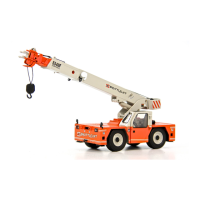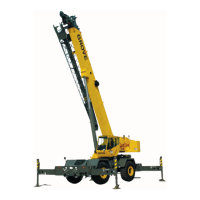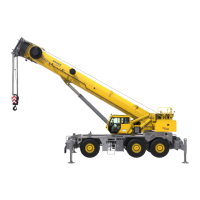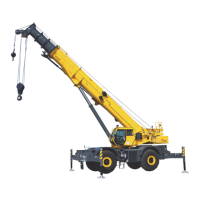HYDRAULIC SYSTEM TMS800E SERVICE MANUAL
2-18
Published 01-29-2014, Control # 496-00
No. 2 Pump Installation
1. Remove the drive pad cover.
2. Apply gasket compound (Spec. 6829013865, Loctite
Master Gasker 518) to the No. 2 pump’s gasket. Place
the gasket on the mounting flange of the pump.
3. Apply medium strength thread locking compound (Spec.
6829012418, Loctite 243) to the two pump mounting
bolts. Install the No. 2 pump on engine drive pad with
bolts and washers. Make sure gear teeth mesh properly.
Torque bolts, refer to Fasteners and Torque Values,
page 1-13. Make sure gasket seals properly.
4. Secure the No. 2 pump to the pump support plate with
the nut and lockwasher. Torque nut, refer to Fasteners
and Torque Values, page 1-13.
5. If you loosened or removed the 3/8-16 bolt to move or
remove the pump support plate, reinstall and/or tighten
this bolt and its washer. Torque bolts, refer to Fasteners
and Torque Values, page 1-13.
6. Connect the distribution and supply lines as tagged
during removal. Apply medium strength thread locking
compound (Spec. 6829012418, Loctite 243) to the bolts
that attach the lines to the pump; discard old O-rings and
use new ones with the lines, bolts, and flange halves.
No. 2 Pump Startup Procedure
1. Ensure the reservoir is filled with the proper hydraulic
fluid to the high level mark on the reservoir sight gauge.
2. Ensure no air is entering the pump inlet, and that the
pump suction or inlet fluid is not bleeding back to the
reservoir when the engine is stopped, by making sure all
suction or inlet lines are air tight.
3. Remove all pump outlet hoses. Fill pump outlet port of
each pump section with as much hydraulic oil as it can
take. Connect all pump outlet hoses again.
4. Start the engine and idle it for two or three minutes
without running any hydraulic functions. Check for leaks;
as needed, stop the engine and make repairs.
5. Place your hand on the pump to check for excessive
heat buildup. If the pump is too hot to keep a hand on,
stop the engine. Each section should feel about the
same warmth, but pressure drops in each pump
section’s circuit would explain some difference between
the two.
6. Listen for abnormal noises indicating low hydraulic oil
level or internal pump problems. If the pump is making
excessive noise, it is probably sucking air into its inlet,
keeping it from priming. In case of abnormal noise, stop
engine, and inspect the pump and the suction line for a
loose connection, a leak, or a damaged or missing O-
ring.
7. If the pump seems to be running properly, increase the
rpm to 1500 to 1800 rpm for one to two minutes while
operating no hydraulic functions. Repeat checks in steps
4, 5, and 6.
8. Increase engine speed in steps to full RPM. Repeat
checks in steps 4, 5, and 6.
9. Cycle the components the pump sections power to verify
the pump sections drive them properly. Verify there is no
leaking.
10. Check pressure settings. Refer to Pressure Setting
Procedures, page 2-24 in this section.
CAUTION
Do not feed hot hydraulic oil into a cold pump. This may
cause the pump to seize.
CAUTION
If the pump becomes hot to the touch, it is binding and
may seize. Stop engine, disassemble pump, and repair it
so it will not bind.
Reference Only
